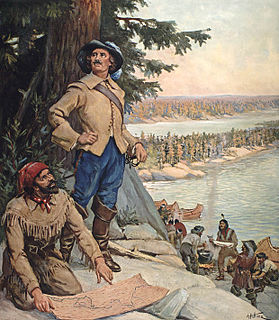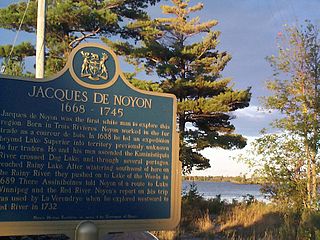Related Research Articles

Pierre Gaultier de Varennes, sieur de La Vérendrye was a French Canadian military officer, fur trader, and explorer. In the 1730s, he and his four sons explored the area west of Lake Superior and established trading posts there. They were part of a process that added Western Canada to the original New France territory that was centred along the Saint Lawrence basin.
La Vérendrye, La Verendrye or Verendrye may refer to:

Events from the year 1738 in Canada.

La Vérendrye wildlife reserve is one of the largest reserves in the province of Quebec, Canada, covering 12,589 square kilometres (4,861 sq mi) of contiguous land and lake area. It is named after Pierre Gaultier de Varennes, sieur de La Vérendrye, a French-Canadian explorer. Located 180 kilometres (110 mi) north of Ottawa, it is traversed from south to north by Route 117.
The Vérendrye stone was allegedly found on an early expedition into the territory west of the Great Lakes by the French Canadian explorer Pierre Gaultier de Varennes et de La Vérendrye, in the 1730s. It is not mentioned in the official records of La Vérendrye's expeditions, but in 1749 he discussed it with visiting Swedish scientist Pehr Kalm, from whose writings virtually all information about the stone is taken.

Louis-Joseph Gaultier de La Vérendrye was a French Canadian fur trader and explorer. He, his three brothers, and his father Pierre La Vérendrye pushed trade and exploration west from the Great Lakes. He, his brother, and two colleagues are thought to be the first Europeans to have crossed the northern Great Plains and seen the Rocky Mountains in Wyoming.

Jean-Baptiste Gaultier de la Vérendrye was the eldest son of Pierre Gaultier de Varennes et de La Vérendrye and Marie-Anne Dandonneau Du Sablé. He was born on Île Dupas near Sorel, New France

Pierre Gaultier de La Vérendrye de Boumois was the second son of Pierre Gaultier de Varennes, sieur de La Vérendrye. An explorer and fur trader who served many years under the command of his father, he was born on Île aux Vaches, near Sorel, New France.
François de La Vérendrye was a Canadian explorer. He was the third son of Pierre Gaultier de Varennes, sieur de La Vérendrye. He was born at Sorel, New France in 1715 and was active in his father's trade activities from Fort Kaministiquia to the North Saskatchewan River.
Jacques Legardeur de Saint-Pierre was a Canadian colonial military commander and explorer who held posts throughout North America in the 18th century, just before and during the French and Indian War.

Fort La Reine was built in 1738 and is one of the forts of the western expansion directed by Pierre Gaultier de Varennes et de La Vérendrye, first military commander in the west of what is now known as Canada. Located on the Assiniboine River where present day Portage la Prairie, Manitoba, stands, the fort served as a fur trading post. It was also the base of operations for much exploration north and west. From Fort La Reine, explorers made their way to Lake Manitoba and Lake Winnipegosis, Lake Winnipeg and the Saskatchewan River.

Fort Maurepas was the name of two forts, or one fort in two locations, built by the French in the Lake Winnipeg area in the 1730s. They were both named after Jean-Frédéric Phélypeaux, Count of Maurepas who, as Minister of Marine, was in charge of French colonies and chief adviser to King Louis XVI.

Events from the year 1736 in Canada.
Fort Rouge was a fort located on the Assiniboine River in Manitoba, Canada, on the site of what is now the city of Winnipeg. Its exact location is unknown. Its name in English means "red fort".
La Verendrye Provincial Park is a waterway provincial park located in Ontario, Canada, on the border of Minnesota, United States. The park stretches from Quetico Provincial Park through Saganaga Lake, up the Pine River, across the Height of Land Portage, then down the Pigeon River to Pigeon River Provincial Park on Lake Superior. The park is named after Pierre Gaultier de Varennes, sieur de La Vérendrye an early explorer of Canada.
René Gaultier de Varennes is best known in Canadian history as being one of the early governors of Trois-Rivières, Quebec and the father of Pierre Gaultier de Varennes, sieur de La Vérendrye, a famous Canadian explorer and fur trader. Part of the Ancien Régime, the Gaultier family of aristocrats came from the Anjou area of France.

Jacques de Noyon was a French Canadian explorer and coureur des bois. He is the first known European to visit the Boundary Waters region west of Lake Superior.

The Verendrye Site is an historical archaeological site off Verendrye Drive in Fort Pierre, Stanley County, South Dakota, United States. Now a small public park, it is the place where the La Vérendrye brothers, the first known Europeans to explore this area, placed a lead plate bearing the crest of France, to claim the territory for their homeland, during their 1742-43 expedition to the Rocky Mountains.
The Vérendrye brothers were the first Europeans to cross the northern Great Plains and see the Rocky Mountains (1742–1743). We know very little about their journey. All we know comes from a journal found in the French archives in 1851 and a lead plate commemorating the journey which was found in 1913 buried near Pierre, South Dakota. The journal and lead plate are difficult to interpret. The journal states the trip may have been made by the "Chevalier Vérendrye and one of his brothers" who are otherwise unidentified. Most likely the Chevalier was Louis-Joseph Gaultier de La Vérendrye and the brother was François de La Vérendrye but we cannot be sure. The mountains they saw during their expeditions may have been the Big Horn Mountains of Wyoming, but could also have been the Black Hills or the Laramie Mountains
The La Vérendrye Trail is a series of highways in the Canadian province of Manitoba commemorating the oldest waterway fur-trading route in the province. It is named after Pierre Gaultier de Varennes, sieur de La Vérendrye, an explorer and fur-trader who is often credited as being the first European to visit what is now southern Manitoba.
References
- The Journals and Letters of Pierre Gaultier de Varennes de la Vérendrye and His Sons, edited by Lawrence J. Burpee, the Champlain Society, 1927.
- "Vérendrye, Pierre Gaultier de Varennes, sieur de la", The 1999 Canadian Encyclopedia: World Edition CD ROM, McClelland & Stewart Inc.
- "Historian says abolished U.S. Verendrye Nat'l Monument may be correct site of explorers' stop—after all!", by Michael Marlin, Montreal Express Weekly, Vol. 5, No. 4, April 12, 2003, pp. 12–13.